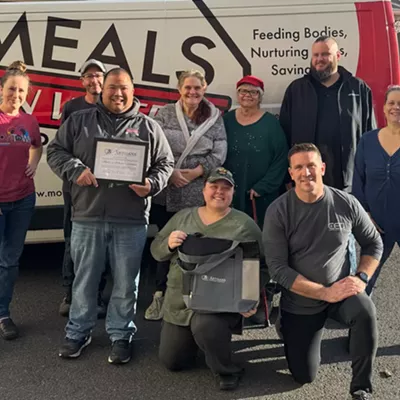Diets come and go. And if you've jumped on, and off, of any fad diet bandwagon, you probably know that often the weight does, too.
Experts say fad diets are nearly always bound to fail. "Any diet is going to be ineffective because it's not teaching you the skills to follow your own hunger," says Angela Pham, a Spokane-based dietitian. "The body is very resilient, and if you stop dieting, you can become an intuitive eater again. But dieting is going to take you further and further away from that."
Pham says chronic dieters, people who've tried four, five, six diets in their lives, actually stand to benefit even less from dieting. She says her clients who've tried popular diets such as the Ketogenic and Paleo plans tend to quickly gain back the weight they lost — and then some — after they abandon the regimen.
We talked with Pham and other experts about four popular eating plans: the Ketogenic diet, the Paleo diet, the Whole30 program and the Flexitarian eating plan.
Thousands of people have found varying levels of success and benefits for each. However, these experts warn against dieting in general. And new variations on old themes are no exception.
"Diets should have warning labels on them," Pham says.
PALEO
Key Features: Lifestyle change that can produce weight loss, but also aims to reduce lower inflammation and reduce risk for various diseases of aging
What's In: Meat, seafood, eggs, vegetables, nuts, fats and oils
What's Out: Processed foods, as well as gluten, grains and refined sugar and additives
The Paleo diet is a plan intended to mimic foods that our caveman ancestors would have eaten 10,000 years ago. It limits followers to foods that would have been available to hunter/gatherer types such as meats, eggs, fish, fruits and vegetables. The diet eliminates many popular foods such as dairy products, cereal grains and legumes including beans and peanuts.
The thinking stems from what's known as the "evolutionary discordance hypothesis," which says modern diets born of the agricultural revolution clash with our own evolution. Processed foods, grains and dairy are major contributors to obesity, diabetes and heart disease, according to the hypothesis.
Exercise is also a major part of the Paleo eating plan, as it attempts to reflect not only how early humans ate, but their level of physical activity as well.
The emphasis on fruits and veggies is generally in line with the Dietary Guidelines for Americans put out by the U.S. Office of Disease Prevention and Health Promotion. But Dr. Angie Eakin, a Spokane physician who specializes in family medicine and has a master's degree in nutrition, is concerned about the diet's strict restriction of dairy and grains, which would deplete your diet of essential nutrients in those foods, such as calcium and vitamin D.
And she questions the rationale behind the diet. "Healthy cultures eat a lot of beans and whole grains and fruits," Eakin says. "And we know that's what's keeping people healthy now, so I don't think it's best to avoid those things."
Nonetheless, Paleo's popularity has risen beyond just an eating plan. There are entire magazines dedicated to the Paleo lifestyle. Paleo f(x) is an annual three-day event with Paleo vendors, speakers and workshops. There are also Paleo beauty products, sleep masks and action figures. Spokane dietitian Michelle Weinbender says at least parts of the theory behind the Paleo diet make sense, though she worries those who chose to follow the plan will find it difficult to sustain long term.
"Our food supply is so drastically different than it was back then," she says. "But I think it's brought about some different approaches to food like eating closer to the ground, more locally grown, sustainable kind of eating."
WHOLE30
Key Features: Similar to, but more restrictive than, Paleo. Whole30 is short-term, one month and features a detailed "reintroduction" plan at the endpoint
What's In: Meat, seafood, eggs, lots of vegetables and some fruits
What's Out: Sugar — in all forms. Alcohol of any kind, dairy and numerous food additives. If you mess up, you have to start your 30 days over
The Whole30 program is less of a diet, and more of a "nutrition reset" according to the plan's founder, Melissa Hartwig. The thinking is that certain foods contribute to a range of conditions from low energy levels to digestive issues to chronic pain. Under the Whole30 plan, followers eliminate specified food groups for a full 30 days and then slowly reintroduce them. The goal is to rethink how you eat and, in the process, identify foods that contribute to chronic health issues.
Hartwig promises life-changing results.
The plan eliminates added sugar, alcohol (even for cooking), grains, dairy, legumes and baked goods even if the ingredients are allowed in the Whole30 regimen. The Whole30 concept has surged in popularity recently since its introduction in 2009. While some people have found success, nutritionists are not exactly loving it.
Eakin sees two issues. First, the strict 30-day regimen does nothing to help people manage their weight in the long term. Though Hartwig has said that weight loss in the Whole30 plan is an added benefit, it's not the primary objective.
Second, Eakin is baffled, again, by the Whole30's restriction on beans and legumes.
"The longest living cultures in the world eat beans every day and have lower rates of cancer, diabetes and heart disease than Americans," she says. "Legumes are a highly nutritious source of protein, and they are also one of the best sources of dietary fiber, which aids in digestion, blood sugar control, blood cholesterol and can with with satiety and therefore weight control."
For two local women who've followed the Whole30 plan multiple times, the results are mixed. Jenni Irving started following the plan about three years ago after she was diagnosed with irritable bowel syndrome. By eliminating certain foods for 30 days, and then slowly reintroducing them into her diet, she says she has identified which foods she can't tolerate.
For better or worse, dairy foods are out, replaced with coconut milk and nut-based cheeses, says Irving, who has completed multiple 30-day cycles, though not consecutively.
After the first 30-day run, Irving says she lost about 12 pounds. But with each subsequent try, the weight loss was less noticeable.
Alisha Merkt, who has also completed the 30-day program multiple times, was inspired by Irving to try it with the goal of feeling healthier overall. Although she lost between 20 and 30 pounds the first time, she gained it all back as soon as the 30 days were up.
Both women say they felt better (more energy, better sleep) while following the diet, but only after about two weeks of "misery."
"Those first two weeks are hard," Irving says. "It's like you're going through very serious withdrawals."
For Merkt, the biggest issue is that the plan is too expensive and time consuming to be sustainable.
"I think the benefits were really fantastic, but it can screw up your view of eating and how you should eat," she says. "You become obsessed with eating, so there are definite downsides to it."
After several rounds of Whole30, Irving says she's done.
"I think it's really dangerous because you start to villainize normal food like rice, peanuts and corn," she says. "So if you don't have a medical reason, and just want to lose weight, there's a lot more healthy ways to go about that."
KETOGENIC
Key Features: On the standard Ketogenic diet, 75 percent of daily calories come from fat, 20 percent from protein and 5 percent from carbs
What's In: Meat, fish, butter, eggs and cheese, as well as nuts, avocados and low-carb veggies
What's Out: Grains, rice, beans, potatoes, any form of sugar, milk, most fruit and high carb veggies
The concept here is not new: it's been used for nearly 100 years as an effective treatment for epilepsy, especially in children.
By seriously limiting carbohydrates, Ketogenic dieters reduce the body's main source of energy. Without enough carbohydrates, the body starts to burn stored fat and goes into a state called "ketosis." It can be an extremely effective way to lose weight relatively quickly, but experts worry about long-term effects.
"People lose weight because your body thinks you're starving because you've taken carbohydrates out of your diet, which is our primary source of fuel," Weinbender says.. "It's not sustainable, and I'm a little worried about it because we don't know the long-term effects of being in ketosis."
Ketogenic dieters are told to eliminate beans, legumes and whole grains, along with some fruits that contain vitamins and minerals that aren't available anywhere else. Bananas, apples and oranges are out; avocados and berries are allowed in moderation.
Eakin raises similar concerns about the diet's unknown long-term effects. In addition, research on side effects is contradictory. Though some studies showed improved cholesterol and blood sugar control, she's seen people's cholesterol levels skyrocket and their insulin resistance increase in a matter of weeks. Insulin resistance can lead to diabetes, she says.
Although Eakin recommends against the Ketogenic diet, those determined to try it should consider eating more plant fats — olives, seeds, avocados -— than focusing on meat fats, "so at least they're getting some antioxidants and fiber and really healthy foods in their diet at the same time," she says. "I think it's a way people can lose weight, but I can't say I think it's the healthiest way to lose weight."
FLEXITARIAN
Key Features: A lifestyle approach that emphasizes vegetarian eating, with lots of plant-based variety, and occasional meat/poultry/fish.
What's in: Gradual transition to a healthier, satisfying plant-based diet.
What's Out: Rules about what you can't eat; instead the focus is on what you can eat, with the hope that the new, and nutritious, foods replace less healthy choices from the past.
Of the four eating plans featured here, Eakin's favorite is a Flexitarian diet.
"It's the diet pattern closest to how I eat," she says. "I think the overwhelming majority of evidence suggests that the more whole plant foods you eat, the healthier you're going to be from any standpoint: weight, blood pressure, diabetes, risk of cancer."
The name sums it up well. Unlike other diets, the Flexitarian plan doesn't eliminate entire food groups. Rather, the idea is to focus on eating a mostly plant-based diet with the option of occasionally adding meat. Eakin suggests lean meats such as chicken (without the skin) and fish.
Pham, the local dietitian, agrees. She says the Flexitarian plan has the most research supporting it.
"Your eating should always be flexible, and stick with the seasons," Pham says.
"The longest living countries in the world, which tend to be the healthiest, by far eat mostly plant-based diets," Eakin says. "There's evidence from different countries and different continents that eating a Flexitarian diet has better health outcomes and results in good quality of life and more years of life." n



















